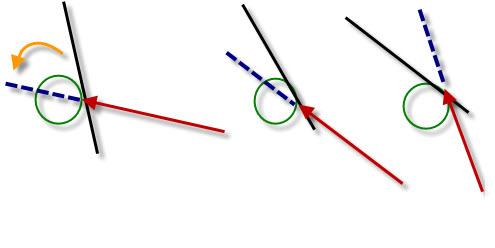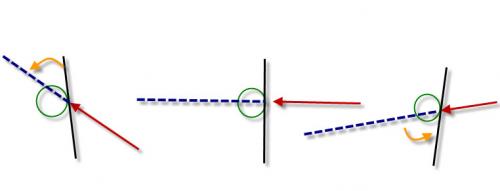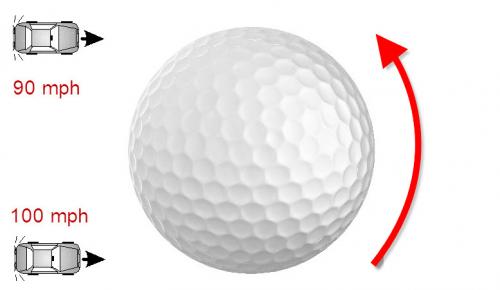The Flight Of The Bumble Bee...And Flying Golf Balls
- by Kelvin Miyahira
Perhaps many of us are old enough to have gone through grade school with the notion that bumble bees should not be able to fly. Based on mathematical/aerodynamic models and calculations from the time of the Wright brothers’ era, the scientists declared no way the bumble bee could fly. Yet it did. So were those scientists wrong? Of course they were. But did they have enough information? Not until high speed cameras were developed could they actually see what the bumble bee was doing in order to fly.
Research article: "Smoke visualization of free-flying bumblebees indicates independent leading-edge vortices on each wing pair"
According to this most recent study, the idea that the wing of a bumble bee treated as a flat plate is the problem. Here’s the direct quote. “Most recent studies of the unsteady, separated-flow aerodynamics of insect flight have used physical, analytical or numerical modeling based upon simplified kinematic data treating the wing as a flat plate.” The findings point to the bumble bees’ wings having the ability to create camber and twist instead of only flapping up and down as previously thought. Using a little smoke and super high speed video, the scientists are able to see leading edge helical vortices created by the bees’ wings that allow flight.
In retrospect the author says, “Simplified models of insect aerodynamics ought ideally to be tested against data from real insects.”
See the wings flapping in the golf impact interval
Perhaps it is time to take a closer look at impact to see what’s really going on in the real world of impact duration dynamics. I recently obtained a Phantom ultra high speed video camera capable of shooting over 100,000 frames per second. With frame rates that high, one can see asymmetrical ball deformation, dynamic club movements and resultant spin in the 40-50 frames of the impact interval.
Phantom Clubhead movements
We have not seen the bumble bee’s wings flap before with high enough resolution and from the correct angle to remove 2D distortions so we can see the face angle and the swing path in great detail. Thus many of these movements may not be so intuitive to you.
So here are my initial observations. We will be doing deeper analysis of all these aspects in the future but just this should be enough to understand that this is the reality of what’s going on in the impact interval.
- Clubface angle at initial point of contact varies but…..
- Clubface angle can change in first half of impact duration
- Open
- Close
- Or stay steady
- Clubface angle can change in second half of impact duration
- Open
- Close
- Or stay steady
- Loft can:
- Increase
- Decrease
- Steady
- Path can:
- Shift right of target
- i.e. - A steady, square clubface angle to the target with a path moving right = increasingly closed clubface to path.
- A closing clubface with the path shifted to the right = massive hook
- Shift left of target
- i.e. – A steady, square clubface to the target with path shifted left = an opening clubface.
- An opening clubface with the path shifted left = huge slice
- Steadily move in initial direction
- Angle of attack prior to contact can be:
- Up
- Down
- Level
- Shifts down upon impact by about ¼”.
- Rate of closure (face angle to path) varies from golfer to golfer depending on release style
- Can be high like over 10,000 d/sec
- Will cause draws with clubface open to path
- Can be under 1000 d/sec
- Clubface can move closed to open or open to more open
- Slicer can have the clubface opening while path is moving left. That equals a huge negative closure rate.
- Contact Location effects
- Heel
- Causes closing of the face
- Toe
- Causes opening of the face
- Fast rolling can close the clubface despite toe hit
- Center
- High on face
- Adds loft
- Low on face
- Decreases loft
- Gear Effect
- Big Mystery
- With toe strikes the clubface is still closing while on the ball. The clubface is kicked open after the ball has left the clubface in many instances. Could too slow a camera fail to pick up this important fact and cause researchers to observe a draw with the clubface opening?
- With irons, heel strikes appear to create a draw spin instead of a fade spin
With this many dynamic variables, would it even be possible to create a mathematical model to precisely calculate where the golf ball is flying based on what we’re seeing with the Phantom? Possibly... in the future this could be done. But what about D Plane??? Doesn’t it take into consideration all these variables?
Perhaps the major contributor to where the ball flies is rate of closure, yet the D Plane simply assumes rate of closure to be ZERO. Path is not static either. It can shift left or right during the impact interval thus causing changes in face to path and therefore spin axis direction.
I realize this is incredibly complex but if you want to understand the flight of the bumble bee, this is where it’s at. There isn’t a lot of research of real golfers in this area and surely not at a high enough frame rate to see the wings flapping.
The world is not flat
I feel like Christopher Columbus in saying this since the entire industry is saying the exact opposite from what I’ve seen. People are saying that a high closure rate leads to slicing and a low closure rate leads to hooking. These same people see the gear effect being primary in dictating where the ball flies while my initial observations lead me to the opposite conclusion… that it is a secondary effect.
So before I try to explain golf balls colliding with clubheads, let’s take a look at another sport that I’ve done research in, tennis.
Tennis Topspin
Perhaps an easier topic to broach than golf, the topspin forehands of Roger Federer, Novak Djokovic and Rafael Nadal are so astounding that the three players have won 28 of the last 29 majors up until Andy Murray won the US Open this year. The technical differences in their strokes (in comparison to the traditional “brush” or “windshield wiper” stroke) have not escaped the watchful eye of Dr. Calvin Nii who has studied the evolution of the game for over four decades. So imagine the skepticism when he read this article by the New York Times.
According to the scientists at Wilson, three factors create spin in tennis; “the speed at which the racket is swung, the angle at which it connects with the ball, and the snapping back into place of the strings after they are displaced by the initial contact with the ball.”
Maybe only a scientist like Dr. Nii could scrutinize such a study with an unbiased eye. The study was done by clamping the racket onto a fixed base and shooting tennis balls out of a cannon at different angles to determine spin rate based on the varying angles. Do people play tennis this way? Oversimplified is an understatement.
Golf equivalent
We have golf balls struck by robots with little or no closure rate and observe where the ball flies with open/closed/square clubfaces. Really???
Or how about shooting golf balls at a suspended piece of wood to verify the gear effect? Is that the same as hitting a golf ball with a fast closing clubface? http://www.physics.usyd.edu.au/~cross/PUBLICATIONS/37.%20GearEffect.pdf
Tennis and Golf: Different goals
In tennis, the Big 3 dominant players use high ball speed and high topspin rates to win. Due to the limitations of court size, it makes no sense to hit 100 mph with little topspin since the ball will fly long and out of the court. In golf, we want high ball speed and minimal sidespin/minimal backspin (with driver) in order to hit the ball straight and far. Thus our sports have different goals. So let’s take a look at collisions in tennis to help us understand a bit about collisions in golf.
In order to generate massive topspin and ball speed at the same time, some interesting events are occurring simultaneously with Roger Federer’s forehand.

Racket Face
Roger’s racket face is turning down fast (can we say closure rate?) while the ball is in contact with the strings? This is shot at 210 fps so we are going to have to extrapolate in our minds. Since the ball is in contact with the strings for 4-5 milliseconds (that’s 10 times longer than golf ball/club contact time), that’s an awfully short period of time!!! Can the racket close in that short a period of time? Oh yeah!
And what if the racket face were moving like Maria Sharapova’s?

Doesn’t this produce a flatter or lower topspin shot?
Racket Face vs. Path


What if racket path and racket angle become nearly parallel to each other vs. staying at right angles? In other words Roger’s racket rotates another 90 degrees more than Sharapova’s in relation to the path. Though much of the rotation occurs after the ball has left, it does give a clue as to what Roger is actively doing during the impact interval. What does that do to the amount of topspin? Increases it dramatically!
Perhaps it’s important to know that Sharapova is hitting a flatter shot. She’s actually turning her racket face more open as she hits through the shot via right forearm supination while holding right wrist extension. Federer on the other hand is using a combination of wrist flexion, forearm pronation and radial deviation to hit a shot with massive speed and topspin (there’s a bit of hook spin too).
Closure rate
Thus Roger is massively closing his racquet face down while the ball is in contact with the strings and while he’s increasing the vertical path of his racquet. Thus his face to path closure rate is extremely high.
Maria on the other hand is opening her racquet face while the path is moving vertically. This makes her closure rate low. Thus, Maria has a more stable racquet face and wrist which creates a low spin, straight shot. Do you see where I’m going with this?
Contact location
Dr. Nii also has noted that Federer and Nadal tend to hit the ball below the equator which makes the racket face turn down even faster and believes this is responsible for tremendous topspin they have.
Since the gear effect is not in play in tennis due to the center of mass of the racket lying in the plane of the impact surface, we get to see the effects of dynamic collision movements creating the spin on the ball. Here’s a former ATP player from Hawaii hitting massive topspin.
Perhaps this why the top three strike the ball below the equator while trying to create topspin? In fact, Dr. Nii has seen Nadal hit 80% of his shots on clay below the equator. For those that don’t understand tennis, clay courts are slower thus requiring more topspin to win than on faster hard courts so Nadal is trying to hit the ball below the equator even more often.
Here he is trying to hit it flatter. What happens when hitting above the equator? Dr. Nii calls those “airmailed” balls. They have less topspin (for example roughly 1500 rpm on above equator contact vs 3000 rpm on below) on and will tend to fly long and out of the court. Does it make sense that the opening of the racket face while the ball is on the strings will negate some of the topspin created by a closed racket face at the initial contact?
The contact location and the dynamic movements at impact have a huge influence on the generation of spin and the direction of that spin. But if we view impact as an overly simplistic event, how are we truly going to understand the collision and all the variables related to it?

In looking at these diagrams, is the tennis world is stuck on simple as well?

Here’s a different take on the impact interval movements of Roger’s racket. He makes contact with the ball at a slight upward angle (though not as severely upward as conventional tennis strokes). This produces the high ball speed since contact is more through the center of mass of the ball than in traditional windshield wipering/brushing strokes (simple diagram).
Then in middle diagram, the low contact point collision plus the anatomical movements (flexion, pronation, radial deviation) changes the racket path to become more vertical (red arrow) while simultaneously rotating the racket face downward to change the force vector applied to the ball to become more tangential!!! There is even a bit of hook spin if we view this from top view due to racket path moving slightly toward the right. But that’s too complex!

On the other hand, Maria’s forehand does something completely different. As she makes contact, her anatomical movements of (holding wrist extension to slight release toward flexion and supination) are counteracting the topspin initially created to produce a flatter (tennis world lingo for low topspin) shot.
Rotate Impact Image Vertically 45 degrees
So let me finish this tennis and golf analogy. Instead of hitting the tennis ball out horizontally, we put the ball on the tee and hit it in golf. Thus, Roger’s topspin becomes hook spin. Actually for golf Roger would be hitting a smother hook that dives into the ground. Not good for golf.
Maria’s flat forehand becomes a long straight drive with very little hook spin. Is this analogy clear?
The contact location on below the equator for tennis becomes a heeled shot for golf. Hitting above the equator is synonymous with hitting the toe of the golf club.
Anatomical Movements Through Impact
When describing Federer’s anatomical movements of wrist flexion, forearm pronation and radial deviation through impact, am I not describing a flip/roller’s movements as well?
Contrast that to Sharapova’s anatomical movements of holding right wrist extension, forearm supination and ulnar deviation. Isn’t that similar to what a drive/holder is doing in golf?
Release styles and Closure rates
In tennis and golf, there are different releases. That should be very obvious in tennis with the comparison of Sharapova (low closure rate) and Federer (high closure rate). In golf, a robot hitting the ball (low or no closure rate depending on robot) vs. Tiger Woods (high closure rate) hitting a pull hook would be a similar comparison. The robot would hit it straight while Tiger would hit a 30 yard pull hook.
The different release style produces strikingly different racquet/club movements with different closure rates, swing path and direction/amount of spin created.
High closure rate = fade???
For the golfing world that believes a higher closing rate = a fade. Consider this collision:

Suppose two cars colliding with a giant golf ball. One car is traveling at 100 mph and the other is traveling at 90 mph. If both make contact at the exact same time, which direction would the ball spin?


So what if the toe of the club is moving 10 mph faster than the heel?
More Questions
Research does not always produce more answers. In this case, ultra high speed video research of the phenomena of the striking of the golf ball produces more questions.
Why are the straightest shots struck with open clubfaces? Do we really understand how to hit a straight shot?
When the clubface appears to be straight and path straight, why is the ball hooking or pulling left? When a tour pro pulls a shot the announcers inevitably say, “He came over the top of that one.” This assumes his swing path was more to the left than normal. But could it be that his closure rate was a bit faster than normal and this caused a pull?
How powerful is the gear effect in comparison to the anatomical movements that create a high or low closure rate?
Do we understand all the variables involved in creating a repeatable swing motion that can hit shots like a tour pro?
Do tour pros understand what causes the “random error” that creates a nasty double-cross hook despite trying to hit a fade like Tiger is doing now? Tiger should buy a Phantom so he can see what’s causing this for himself rather than relying on overly simplistic, static data that misses the mark.
There’s so much to be learned about the flight of the bumble bee. Stay tuned.
Rick Malm, Jeffy and I will be conducting a research study in Phoenix, AZ next month from December 5th – 10th. We will have the Phantom ultra high speed camera and a Trackman on hand to gather data on golfers of all levels. If you are interested in knowing your rate of closure and why your ball goes where it does, please email me at This email address is being protected from spambots. You need JavaScript enabled to view it. to secure a slot.

